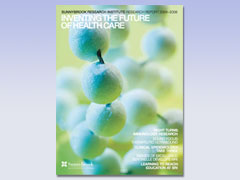Right Turns
Science is discovery as storytelling. But the story unfolds along a nonlinear path. And, eventually, it veers in unexpected directions. "That's where being a good scientist comes in," says Dr. Juan Carlos Zúñiga-Pflücker. "You try to keep making correct turns." Zúñiga-Pflücker, senior scientist at Sunnybrook Research Institute and Canada Research Chair in Developmental Immunology, and Maria Ciofani, a PhD student in his lab, have a knack for right turns. The result is a string of discoveries on T cell development, and charting of new territory in developmental immunology.
T cells are fundamental to immunity; they identify and kill pathogens, including viruses and cancer cells. Understanding the genes and molecules that generate T cells could improve on existing—but largely experimental—types of cancer immunotherapy like vaccine therapies and adoptive T cell transfer (growing large numbers of T cells for injection, shown to eliminate some late-stage cancers). It could also unleash the enormous potential of T cell-targeted pharmaceutical cures for cancer and AIDS.
Sometimes, the correct turn is a 180. In 2002, Ciofani's PhD work wasn't going anywhere. She was trying to define genes and molecules that control T cell development in vivo—because T cell progenitors mature into T cells only inside the thymus. (The thymus is a small organ in the upper chest, to which T cell progenitors migrate from bone marrow.) But that year, Tom Schmitt and Zúñiga-Pflücker induced T cell development in a Petri dish by growing preclinical stem cells, with Delta-like-1 molecules, on supporting stroma. For the first time, scientists could view in molecular detail a process that had stymied them for 40 years. "It saved my degree," Ciofani says.
She and Zúñiga-Pflücker closed the book on her experiments and started down a new path.
Growing large numbers of previously hard-to-find early T cells in vitro, and with a new view into the signaling role of the Delta-like-1 molecule in differentiation (the crucial point when stem cells are directed to choose a lineage and become a specific cell type), Ciofani made a striking discovery about the receptor for Delta-like-1, known as Notch. Notch wasn't only instructing stem cells to become T cells, it was sustaining them after differentiation via another molecule inside the cells, called Akt, and ordering them to take up the nutrients required for their survival. In a fashion described by Zúñiga-Pflücker as typical of her—perfectly laid-out experiments and a rare ability to place them in a larger scientific context—Ciofani took a sharp turn from cell signaling to metabolism, literally looking into the microscope to recognize that removal of Delta-like-1 atrophied the T cells.
Beyond providing a critical piece in the T cell development puzzle, the discovery had clinical relevance for T cell acute leukemia (TALL), in which T cells turn cancerous. Notch is mutated in 50% of TALL patients, so pinpointing how and at what stage it promotes T cell growth opens a promising avenue for investigation into controlling its cell-sustaining effect during TALL. The discovery was featured on the cover of Nature Immunology in 2005.
In 2006, Zúñiga-Pflücker and Ciofani extended this finding. By selectively withdrawing Notch signals in vitro at various stages of T cell development, they determined at precisely what point the two main types of T cells—alpha-beta and gamma-delta, each with particular roles in protecting us from disease—bifurcate from a common T cell progenitor. Only gamma-delta cells will continue developing into mature T cells, despite the absence of Notch function beyond the early progenitor stage of development. While furthering the understanding of Notch, the finding also clarified how to generate the two types of T cells in the lab, thereby facilitating translational research on gamma-delta cells in adoptive T cell transfer therapy. Gamma-delta cells have robust, specific antitumour properties and are much less prone to autoimmunity, a common problem with adoptive transfer.
While Ciofani was mapping preclinical T cell development, Dr. Ross La Motte-Mohs, a postdoctoral fellow in Zúñiga-Pflücker's lab, added weight to her work by replicating their in vitro system with human stem cells drawn from cord blood. Zúñiga-Pflücker says, "It's critical to have the fundamental understanding of genes, molecules and cells, but it becomes a lot more important when you have the human correlate in place and shown playing a role." Published in Blood, the results translated to the human system and, says Zúñiga-Pflücker, "on some levels, provided a more complete sense of T cell development than in the preclinical experiments." La Motte-Mohs and Zúñiga-Pflücker are now partnering with researchers and industry in the Advanced Regenerative Tissue Engineering Centre (see page XX) to explore the feasibility of constructing an artificial thymus for T cell transplantation.
In autumn 2006, Zúñiga-Pflücker confronted the reality that Ciofani will finish her PhD and leave the lab early in 2007. "It's the bittersweet aspect of this work," he says. Once students have developed their experience, worked through failed experiments and multiple forks in the road—just when the science is, hopefully, showing results—they leave. "All you can hope is that they go out and get what they're after," he says.
What is Ciofani after? She's moving to Manhattan to pursue T cell development as a postdoctoral fellow at Memorial-Sloan Kettering Cancer Center. "I want to know," she says. "I think that's probably a little part of every scientist—needing to know the answer. And this is a bit of egotism, but I want to know it first." It is that drive and curiosity that move the story of science forward.
PDF / View full media release »





